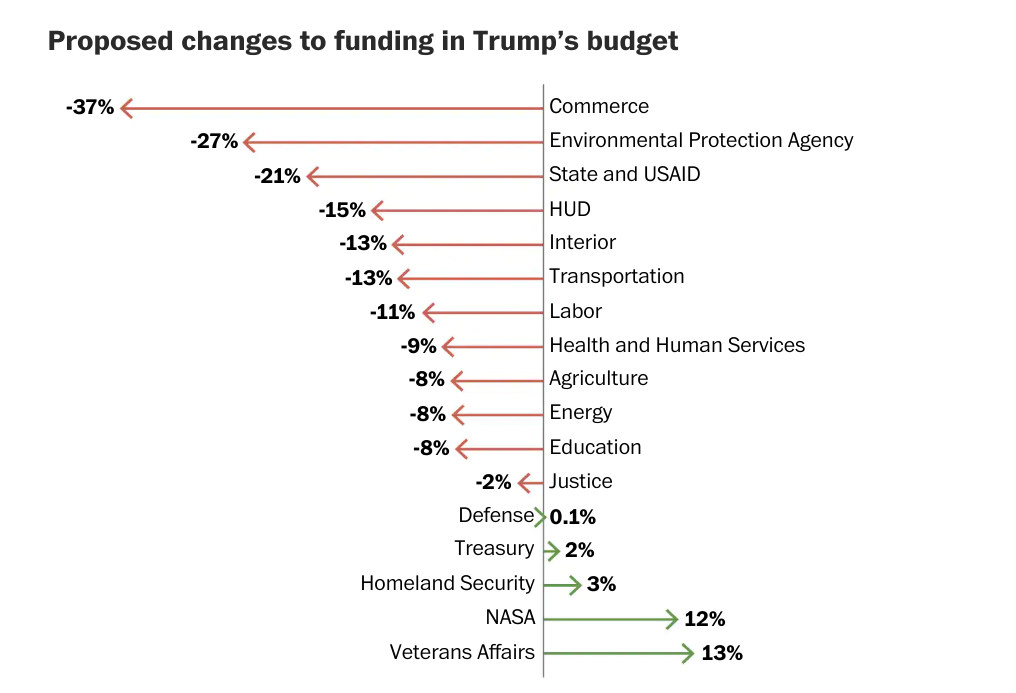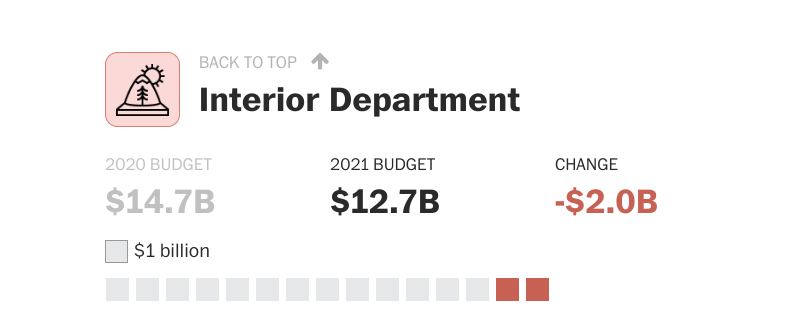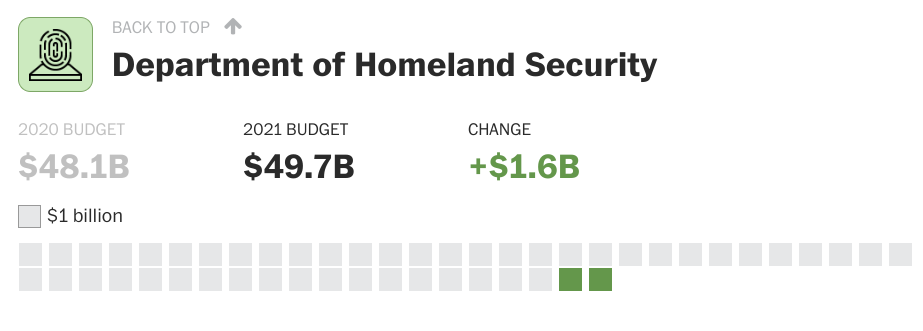Trump proposes $4.8 trillion 2021 (FY) election-year budget with big domestic cuts
 The Trump administration’s new proposed budget is the complete opposite of his Democratic rivals as it suggests deeply cutting some social safety net programs. On February 11, the White House proposed a $4.8 trillion election-year budget, for Fiscal Year 2021 takes aim at slashing major domestic and safety net programs, such as Medicaid, and food stamps for low income people, education, housing and environmental protections, while prioritizing spending on the military and immigration enforcement. According to reporting from the Washington Post the budget would also cut Children’s Health Insurance Program and try to wring in savings from Medicare even though Trump has said on numerous occasions that he would not make cuts to Medicare or Social Security.
The Trump administration’s new proposed budget is the complete opposite of his Democratic rivals as it suggests deeply cutting some social safety net programs. On February 11, the White House proposed a $4.8 trillion election-year budget, for Fiscal Year 2021 takes aim at slashing major domestic and safety net programs, such as Medicaid, and food stamps for low income people, education, housing and environmental protections, while prioritizing spending on the military and immigration enforcement. According to reporting from the Washington Post the budget would also cut Children’s Health Insurance Program and try to wring in savings from Medicare even though Trump has said on numerous occasions that he would not make cuts to Medicare or Social Security.
We will not be touching your Social Security or Medicare in Fiscal 2021 Budget. Only the Democrats will destroy them by destroying our Country’s greatest ever Economy!
— Donald J. Trump (@realDonaldTrump) February 8, 2020
This budget proposal is the last one Trump will submit to Congress before the presidential election in November. The president’s budget proposal is not expected to actually pass Congress but is seen as a blueprint for the administration’s priorities. rAnd as it is taking aim many domestic spending cuts that will surely get rejected by Congress, which chopping the Environmental Protection Agency budget by 26.5 percent over the next year, and cutting the budget of the Health and Human Services department by 9 percent. HHS includes the National Institutes of Health and the Centers for Disease Control and Prevention, which will see a budget cut even as the coronavirus spreads — although officials said funding aimed at combating the coronavirus would be protected. The budget is a proposal to congress, and the lawmakers have mostly denied the White House’s proposed cuts in the previous years. What is significant, is that it lays out the Trump Administration’s policy priorities heading into the election in November and will most likely draw criticism in Washington and by his political rivals on the campaign trail.
One of the departments on the chopping block is the Education Department with an 8 percent decrease in funding, the Interior Department would be cut 13.4 percent, and the Housing and Urban Development department would be cut 15.2 percent. The State Department and U.S. Agency for International Development would be cut by 22 percent.
The Budget Cuts Starkly Contrast the Democratic Rival Proposed Plans
 As we watch the recent Democratic debates and all the potential candidates are claiming that they would expand education, healthcare, environmental protection program spending, this current budget goes in the opposite direction as far as budget priorities. Not every agency is up for cuts, which Trump is planning to increase spending for the Department of Homeland Security while keeping the Pentagon the same as last year. Other spending increases include agency departments such as The National Aeronautics and Space Administration budget would increase by 12 percent as Trump has said he wants the agency to prepare for space travel to Mars.
As we watch the recent Democratic debates and all the potential candidates are claiming that they would expand education, healthcare, environmental protection program spending, this current budget goes in the opposite direction as far as budget priorities. Not every agency is up for cuts, which Trump is planning to increase spending for the Department of Homeland Security while keeping the Pentagon the same as last year. Other spending increases include agency departments such as The National Aeronautics and Space Administration budget would increase by 12 percent as Trump has said he wants the agency to prepare for space travel to Mars.
Even with Cuts, the budget would not eliminate the deficit until 2035
Even with all of these proposed spending cuts, the budget would fall short of eliminating the federal deficit over the next 10 years, missing a longtime GOP fiscal target. So now the WH has adjusted their plans to say their budget proposal would close the deficit by 2035. But according to another Washington Post article, “ it would only achieve this if the economy grows at an unprecedented, sustained 3 percent clip through 2025, levels the administration has failed to achieve for even one year so far.” According to recent data from the U.S. Bureau of Economic Analysis, U.S. economy GDP grew only 2.3 percent in 2019, the slowest level since Trump took office. During Trump’s first year in office, his administration stated their budget plan would eliminate the deficit by around 2028, but this new budget, will be the 3rd year in a row that they abandon their 10 year goal and now are talking 15 years.
This new trend demonstrates how little progress the administration is making with reigning in the ballooning government deficit debt, something past GOP leaders used to make more of a priority of fiscal conservation.
Trump’s first budget projected the deficit in 2021 would be $456 billion. Instead, it is projected to be more than twice that amount. Trump seems to not be terribly concerned about dealing with the deficit and debt, while some GOP leaders say it remains a goal. The $4.8 trillion budget for 2021 would represent a $700 billion surge over levels from 2018.
White House officials have taken the playbook of blaming the Democrats for inaction on the federal deficit. However, Trump has agreed to increase spending throughout the government because it was the condition on which Democrats accepted a higher military budget.
As a presidential candidate, Trump said he would eliminate not just the annual federal deficit but all debt held by the United States after eight years in office. In the Washington Post article Marc Goldwein, a senior vice president at the Committee for a Responsible Federal Budget, which advocates reducing the deficit said “trying to balance the budget in 10 years is very difficult, so having a longer time horizon makes a lot of sense,” and furthered by stating that “fifteen years is still very aggressive.”
The deficit is the gap between spending and revenue, and this year it is projected to breach $1 trillion for the first time since 2012. White House officials have attempted to convey that their budget proposal would make progress toward reducing the deficit by 2030 but not eliminate the gap.
As Trump’s budget includes slashing spending on safety-net programs such as Medicaid and Food stamps, specifically cutting food stamp spending by $181 billion over the next 10 years. It is also proposing squeeze hundreds of billions of dollars from Medicare over the next 10 years via cost savings proposals such as reforming medical liability and modifying payments to hospitals for uncompensated care.
This proposed Trump budget cuts Medicaid spending to a tune of around 920 billion over 10 years, a change Democrats warn cause reductions in benefits and the number of people on the healthcare program. The Trump administration has defended the cut, saying it shows a decrease in the rate at which Medicaid spending would grow rather than a reduction from current spending levels. The administration said it would save money on Medicaid spending through new work requirements and recouping payments incorrectly spent by the federal government. According to reporting from ABC News, White House budget director Russ Vought portrayed cuts in the budget as “saving” that amount to “good government reforms.” Mr. Vought told Fox News “there are changes to mandatory programs that achieve savings that are good government reforms. When we can lower the cost of a CAT scan in Medicare or lower the cost of prescription drugs or have people get back to work with a work requirement in Medicaid or housing programs, those are things that achieve things for taxpayers and help beneficiaries get back to work.”
Others do not agree with this narrative, specifically liberal economists are not buying this argument, “this is a budget that would cause many millions of people to lose health care coverage. That is unambiguous,” said Aviva Aron-Dine, a former Obama official and vice president at the Center on Budget and Policy Priorities, a left-leaning think-tank.
Again another Democrat Congressman Rep. John Yarmuth (D-Ky.), chairman of the House Budget Committee, said early reports indicate the budget includes “destructive changes … while extending [Trump’s] tax cuts for millionaires and wealthy corporations.” If we compare to Obama’s last year in office, the deficit was a little under 600 billion, but it was continued to grow rapidly upward since then.

According to reporting from the Washington Post, the Interior Department’s budget would be cut by 13 percent or $2 billion from the current year. Funds to acquire land for conservation would be reduced, the administration said, along with the money that is currently set aside to help American Indian tribes. Since Trump’s election, land acquisition and conservation have been targeted for cuts. Interior’s budget had grown steadily before the president took office, rising to $13.1 billion. The president’s $12.7 billion requests for Interior will probably be increased by Congress, as it has for the past three years. The administration says that its cuts would save $132 million that could be used to reduce the backlog of maintenance projects at national parks.
The 2017 Trump tax cuts reform TCJA and new domestic spending .which was approved by bipartisan majorities in Congress have played a large role in increasing the deficit gap. Now, there is a new line in Trump’s latest budget summary: “all administration policies will pay for themselves, including extending tax cut provisions expiring in 2025.”
So without further action by Congress and the Trump administration, the individual (non-corporate) tax cuts would expire at the end of 2025. Some Budget experts have made estimate projects that if those individual tax cuts were to be extended would reduce revenue by almost $1 trillion over time.
The biggest chunk of the government’s budget is “mandatory” spending programs that are automatically renewed each year without congressional approval, such as Medicare, Medicaid and Social Security. Trump said on Twitter Saturday that the budget “will not be touching your Social Security or Medicare.” In 2015, he promised not to seek cuts to Medicaid as well, but his budgets have routinely sought big Medicaid changes that would cut roughly $800 billion from the program over 10 years.
Those proposals have not gained a lot of traction in Congress, however, and Trump has not pressured Congress as hard as he has for some of his other priorities (such as funding for a border wall).
 This budget seeks $2 billion in construction funds for Trump’s border wall, down from $5 billion in previous years, in addition to a separate plan to divert $7.2 billion in Defense Department money toward barrier construction. The Trump administration has said that the wall has moved into a new phase, focused on the execution of the project now that funding for it has been secured.
This budget seeks $2 billion in construction funds for Trump’s border wall, down from $5 billion in previous years, in addition to a separate plan to divert $7.2 billion in Defense Department money toward barrier construction. The Trump administration has said that the wall has moved into a new phase, focused on the execution of the project now that funding for it has been secured.
The Washington Post article reports that “the budget document says the administration expects to have completed 400 miles of the new border wall by the end of 2020.” A senior administration official has stated “the president’s budget to fund the wall and border security [comes] with big increases for infrastructure, technology and law enforcement personnel, and this request is based on what’s required to gain operational control of the border.” Trump’s budget proposal would also fund an expansion of the government’s deportation powers by giving an additional $544 million to U.S. Immigration and Customs Enforcement. The money would pay for “an additional 4,636 ICE law enforcement officers, immigration court prosecuting attorneys, and additional critical support staff,” the request states. The White House also wants lawmakers to pay for 60,000 immigration detention beds per day, enough to boost ICE’s jail capacity by more than 30 percent.
Conclusion
Now, if you look at the budget, in summary, it is proposing a 5 percent net cut in domestic discretionary spending, the category of government spending that covers agencies like HHS and the Education Department but does not include Social Security or Medicare.
These proposed cuts fall well below spending caps that lawmakers and the administration already agreed to in a bipartisan budget deal for 2021. That all but ensures the budget will face bipartisan opposition on Capitol Hill. Even with numerous proposed cuts, the budget proposal would not eliminate the deficit until 2035 because of relatively low levels of tax revenue and because big, politically popular programs like Social Security and Medicare would continue to grow. The federal debt has already grown by about $3 trillion under Trump.








